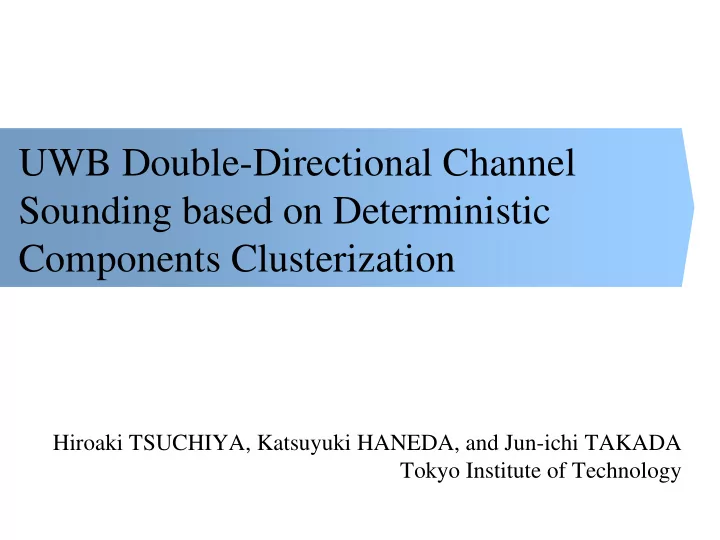

UWB Double-Directional Channel Sounding based on Deterministic Components Clusterization Hiroaki TSUCHIYA, Katsuyuki HANEDA, and Jun-ichi TAKADA Tokyo Institute of Technology
Outline • Introduction • UWB double-directional channel sounding system • Experiment in an office environment • Data processing and analysis • Conclusion 2
Introduction (1) What kind of antenna is better ? New wireless communication systems (wideband) • UWB system performance can suffer from dense multipath propagation. • To evaluate the antenna, a propagation channel model which is independent on the antenna system is necessary. 3
Introduction (2) Radio channel Tx Propagation channel Rx antenna (DoD, DoA, ToA, Spectrum) antenna • Removing the antenna characteristics from every ray-path. • DoD & DoA of the path are also important in a multipath environment. • So to deconvolve the antenna effects, double directional measurement is necessary. 4
UWB double-directional channel sounding system (1) • Double-directional channel measurements 3D array 3D array Channel VNA Tx Rx X-Y-Z X-Y-Z Positioner Positioner Positioner Positioner LNA Controller Controller Laptop GPIB GPIB 5
UWB double-directional channel sounding system (2) • Two single-directional channel measurements are used. Fixed 3D array Rx Tx 3D array Fixed Rx Tx 6
Experiment in an office environment (1) • Empty office room • Top view of the room Rx Tx • The view from the position of Tx to Rx • Four windows and doors, some pillars 7
Experiment in an office environment (2) • Specifications of the experiment Bandwidth 3.1 to 10.6 [GHz] Frequency sweeping points 751 10 × 10 × 7 points in X-Y-Z whose Spatial sampling in the Rx and Tx element spacing is 48 mm (less than half position wavelength in 3.1 GHz) DoD and DoA azimuth, elevation angle, ToA Estimated parameters delay time and spectrum. Type of antennas Biconical Polarization Vertical-Vertical (V-V), Calibration Function of VNA and back-to-back IF bandwidth of VNA 100 Hz Bandwidth of each subband 3.0 GHz 8
Data processing and analysis - SAGE algorithm • Extension of the SAGE for an UWB signal - SAGE Algorithm [1] Widely adopted for wideband channel estimation • To detect paths, Successive Interference Cancellation (SIC) type procedure is used - Remove the reconstructed signal peak from original data [1] SAGE : Space-alternating generalized expectation-maximization algorithm 9
Data processing and analysis • DoDs and DoAs are estimated separately by using two single-directional channel measurements, and they are related by ToA and ray tracing. • 120 waves are detected each at Tx and Rx position. (above noise floor level) • Specular reflections are the dominant phenomena of propagation. 10
Data processing and analysis - Azimuth-delay power spectrum (1) • Tx position • Rx position sidelobe sidelobe • Power spectrum before detecting wave 11
Data processing and analysis - Clusterization of deterministic components • Tx position • Rx position ○ : Single bounce cluster Above - 80 [dB] ◇ - 80 to - 90 [dB] □ - 90 to - 100 [dB] ○ ○ : Multi-bounce cluster - 100 to - 110 [dB] ☓ Below - 110 [dB] * 12 • 15 clusters are found each at Tx and Rx position.
Data processing and analysis - Azimuth-delay power spectrum (2) • Tx position • Rx position • Residual spectrum after detecting 120 waves 13
Data processing and analysis - Identification of the clusters between the Tx and Rx position (1) • Single bounce cluster • Tx position • Rx position Tx Rx Az. [deg] El. [deg] Delay [nsec] Power [dB] Cluster Mean Spread Mean Spread Mean Spread Sum A-Tx 323.81 3.09 -0.19 0.88 33.73 0.71 -80.17 A-Rx 325.97 2.44 -0.10 1.10 33.38 0.59 -79.50 • The clusters both at the Tx and Rx position have the same ToA and 14 identical scatterers.
Data processing and analysis - Identification of the clusters between the Tx and Rx position (2) • Multi-bounce cluster • Tx position • Rx position Rx Tx Az. [deg] El. [deg] Delay [nsec] Power [dB] Cluster Mean Spread Mean Spread Mean Spread Sum G-Tx 22.63 1.93 0.97 1.22 57.01 1.02 -106.05 G-Rx 159.95 11.38 0.20 0.85 56.13 0.90 -109.30 • The clusters both at the Tx and Rx position have the same ToA but 15 different scatterers.
Data processing and analysis - Sum of power for each cluster • Tx position • Rx position Cluster at Sum of Percentage Cluster at Sum of Percentage Tx power [dB] of power Rx power [dB] of power N LOS -70.45 43.70 LOS -69.25 51.64 F D -79.86 5.01 D -79.41 4.98 CI D A A -80.17 4.66 A -79.50 4.87 P N -81.45 3.47 N -80.29 4.06 P -90.26 0.46 P -89.87 0.45 E -92.99 0.24 C -92.67 0.23 C -94.05 0.19 E -92.83 0.23 B -94.26 0.18 I -93.26 0.21 F -95.32 0.14 B -93.54 0.19 J -96.56 0.11 J -95.12 0.13 J B E : : : : : : Residual -71.52 34.11 Residual -72.40 25.02 Total -66.85 Total -66.38 • Clusters in the real environment. 16
CDF of angular and delay spread within one cluster 1 1 0.9 0.9 0.8 0.8 0.7 0.7 0.6 0.6 CDF CDF 0.5 0.5 0.4 0.4 0.3 0.3 0.2 0.2 0.1 0.1 0 0 0 5 10 15 20 0 0.5 1 1.5 2 2.5 Azimuth angular spread [deg] Delay spread [nsec] 17
Conclusion • UWB double-directional measurement in an empty office room • Double-directional channel models are needed for separating the antenna transfer function. • Clusters can be determined by physical structures of the environment. • Sum of power for each cluster • Intra-cluster properties (Mean, spread, CDF) Future work • Antenna deconvolution 18
Thank you for your kind attention ! Hiroaki TSUCHIYA, Katsuyuki HANEDA, and Jun-ichi TAKADA Tokyo Institute of Technology
Recommend
More recommend